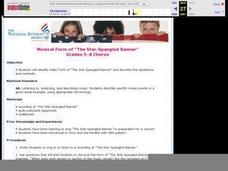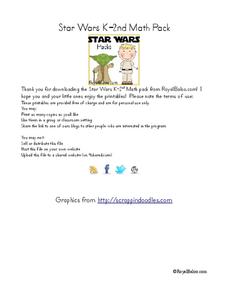University of Colorado
Patterns and Fingerprints
Human fingerprint patterns are the result of layers of skin growing at different paces, thus causing the layers to pull on each other forming ridges. Here, groups of learners see how patterns and fingerprints assist scientists in a...
Star Wars in the Classroom
Star Wars Geography Unit
What kind of animals live on an ice planet like Hoth? How would the habitat on Tatooine allow different organisms to thrive? Connect social studies, science, and Star Wars in one engaging activity that focuses on the ecosystems of the...
Curated OER
Musical Form of "The Star-Spangled Banner"
Students use a recording of "The Star Spangled Banner," to identify the AABC form of the anthem and describe the repetitions and contrasts in the piece of music. They memorize the music in eight-measure phrases being aware of the form...
Curated OER
Stars
In this space science instructional activity, students use the clues to assist them in solving the crossword puzzle on the stars. They identify various constellations and how each rotates.
Las Cumbres Observatory
Star In a Box
Stars may all look the same from down here, but their surfaces tell a different story. Using an animation, learners collect data about the temperature and luminosity of stars and compare them to their mass and radius. They then answer...
Space Awareness
Make a Star Lantern
Go star-gazing with young learners! They study the history, origins, and patterns of constellations in an activity that explores the starry night sky.
Space Awareness
Star in a Box
What happens to stars as they get older? A simulation takes pupils through the life cycle of stars based on their masses. The resource introduces the Hertzsprung-Russell diagram and the common relationships and life cycle patterns observed.
Curated OER
Number Patterns
An easy way to introduce numerical patterns, these activities can be made simpler by using addition, or more difficult with division, fractions, and percentages. Children examine patterns and determine the missing number in the sequence....
Academy of American Poets
Teach This Poem: “Dead Stars” by Ada Limón
Pay attention! A lesson featuring Ada Limon's poem "Dead Stars" is designed to help learners develop their noticing skills. Class members first study the constellation Orion's image and list what they notice and how the image makes them...
Curated OER
Ocean Exploration: Shapes and Patterns Under the Sea
So many shapes in our vast oceans. Young explorers can discover new shapes in a variety of ways in this lesson. One way is having free exploration with a pattern shape kit handed out by the teacher. Another is by viewing a video, Ocean...
Royal Baloo
Star Wars K-2nd Math Pack
Included in a Star Wars themed packet, young padawans enhance mathematical skills such as graphing, computing using basic operations, counting numbers and money, telling time, and measuring. Scholars play a game of sudoku, read number...
CK-12 Foundation
Writing Basic Equations: Stars and Moons
You'll be over the moon about finding a useful resource for describing patterns. Aspiring mathematicians drag moon and star shapes to complete a shape pattern. Additionally, they must write an algebraic equation to describe the pattern.
Curated OER
Stars and Constellations-Pattern Recognition
In this stars and constellations instructional activity, students study a given constellation and identify the stars in the constellation. They label the stars in the constellation and identify the months the constellation is visible....
Curated OER
Draw the Next Pattern
In this pattern worksheet, students view five different patterns and complete the missing object for each pattern. The patterns consist of stars, hearts, and shapes.
Curated OER
Twinkle, Twinkle, Little Star
Learners identify patterns in the stars. For this constellation lesson, students simulate constellations using black canisters and patterns. Learners discuss the points on the constellations and how to draw imaginary lines to see the...
Curated OER
Life Cycle Of Stars
Students analyze characteristics that indicate human life cycles, and then apply these observational principles to various NASA pictures of stars to synthesize patterns of stellar life cycles. They observe NASA images of stars at various...
Curated OER
Spectral Classification of Stars
In this spectral composition of stars worksheet, students use data collected by a spectroscope to compare the stellar spectra to a standard for 5 stars. Students compare the spectral lines to the temperatures of the stars.
Curated OER
Stars and Constellations
Ninth graders investigate how ancient cultures viewed their world in terms of astronomy. They read and discuss an informational handout, construct an astrolabe, and locate stars and constellations using star charts.
Curated OER
Pre K Learn About Patterns
Students create patterns. In this patterns lesson, students view examples of patterns, walk around the school and identify patterns and complete pattern interactives. Students create patterns with KidPix and with objects.
Curated OER
What's Next?
Teach the class how to continue a given number pattern, and have them state a rule to explain their answer. Arithmetic sequences and related worksheets are used to reinforce the concept of numerical patterns using the nthterm.
Curated OER
The ai and ar Sounds
These words sound the same but are spelled differently, giving scholars a chance to practice spelling patterns and rhyming words. First they read that the /ai/ vowel sound can be made with three different spellings. Learners label three...
Curated OER
The Maze
There's only one way out of this maze, and youngsters will need to use their shape recognition skills to do it! They follow a three-shape pattern all the way from start to finish to keep on track. Encourage them to say the shapes as they...
Curated OER
How Old Are the Stars?
High schoolers determine the age of a star cluster by observing, measuring, and plotting astronomical data. They examine the Jewe lbox cluster, located within the southern constellation Crux and determine its age.
Math Stars
Math Stars: A Problem-Solving Newsletter Grade 6
Think, question, brainstorm, and make your way through a newsletter full of puzzles and word problems. The resource includes 10 different newsletters, all with interesting problems, to give class members an out-of-the box math experience.

























